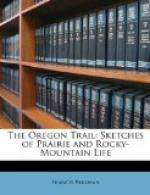As I rode out, a train of emigrant wagons was passing across the stream. “Whar are ye goin’ stranger?” Thus I was saluted by two or three voices at once.
“About eighteen miles up the creek.”
“It’s mighty late to be going that far! Make haste, ye’d better, and keep a bright lookout for Indians!”
I thought the advice too good to be neglected. Fording the stream, I passed at a round trot over the plains beyond. But “the more haste, the worse speed.” I proved the truth in the proverb by the time I reached the hills three miles from the fort. The trail was faintly marked, and riding forward with more rapidity than caution, I lost sight of it. I kept on in a direct line, guided by Laramie Creek, which I could see at intervals darkly glistening in the evening sun, at the bottom of the woody gulf on my right. Half an hour before sunset I came upon its banks. There was something exciting in the wild solitude of the place. An antelope sprang suddenly from the sagebushes before me. As he leaped gracefully not thirty yards before my horse, I fired, and instantly he spun round and fell. Quite sure of him, I walked my horse toward him, leisurely reloading my rifle, when to my surprise he sprang up and trotted rapidly away on three legs into the dark recesses of the hills, whither I had no time to follow. Ten minutes after, I was passing along the bottom of a deep valley, and chancing to look behind me, I saw in the dim light that something was following. Supposing it to be wolf, I slid from my seat and sat down behind my horse to shoot it; but as it came up, I saw by its motions that it was another antelope. It approached within a hundred yards, arched its graceful neck, and gazed intently. I leveled at the white spot on its chest, and was about to fire when it started off, ran first to one side and then to the other, like a vessel tacking against a wind, and at last stretched away at full speed. Then it stopped again, looked curiously behind it, and trotted up as before; but not so boldly, for it soon paused and stood gazing at me. I fired; it leaped upward and fell upon its tracks. Measuring the distance, I found it 204 paces. When I stood by his side, the antelope turned his expiring eye upward. It was like a beautiful woman’s, dark and rich. “Fortunate that I am in a hurry,” thought I; “I might be troubled with remorse, if I had time for it.”
Cutting the animal up, not in the most skilled manner, I hung the meat at the back of my saddle, and rode on again. The hills (I could not remember one of them) closed around me. “It is too late,” thought I, “to go forward. I will stay here to-night, and look for the path in the morning.” As a last effort, however, I ascended a high hill, from which, to my great satisfaction, I could see Laramie Creek stretching before me, twisting from side to side amid ragged patches of timber; and far off, close beneath the shadows of the trees, the ruins




